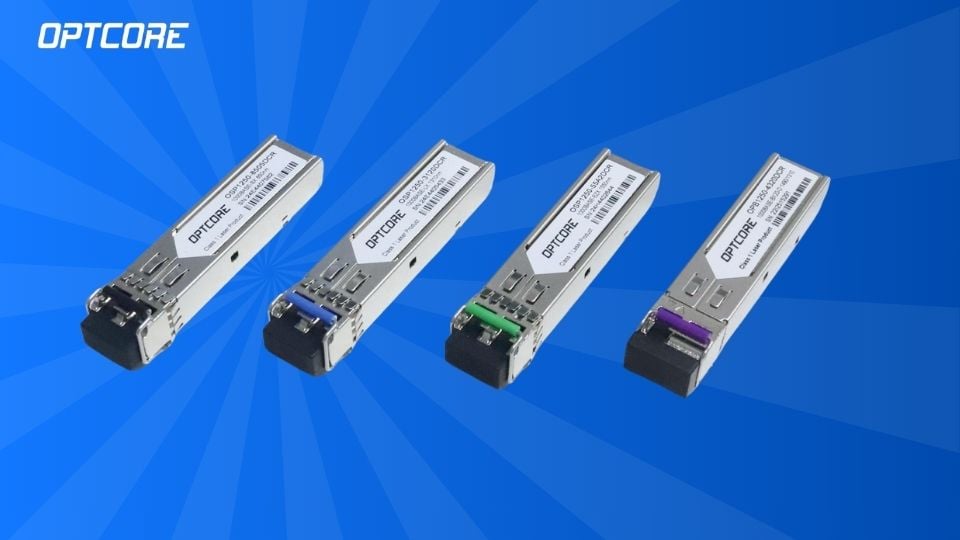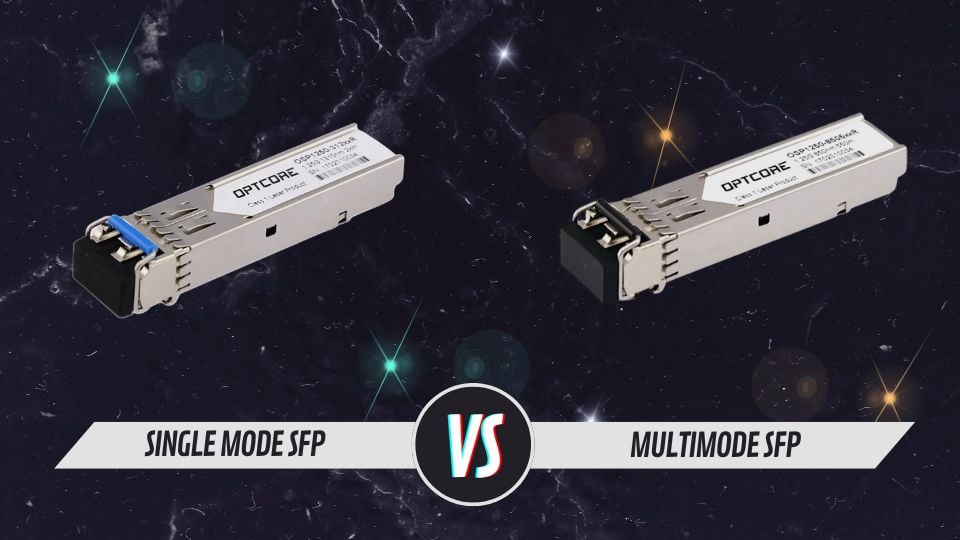Blog, Optical Transceiver
Single Mode SFP vs Multimode SFP: What the Differences Are & When to Use Each
Although you can search many results on Google for single mode SFP vs multimode SFP, most of them may not be written by genuine optical transceiver technicians. As a result, much of the content tends to be similar and lacks real-world experience.
That is why I created this post. As a professional SFP expert in this industry for over 10 years, I have been involved in both SFP modules and experienced most problems and questions from end users and manufacturers. I have covered nearly all the single and multimode SFP topics, aiming to help you understand the difference and how to choose between them.
Now, let’s dive in.
What is Single-mode SFP?
Before we compare them, we need to know their brief definitions. A single-mode SFP is specially used with the 9/125µm single-mode fiber (SMF) but can not be used with multimode fiber cable. It utilizes ultra-low optical attenuation for medium to long transmission.
The single mode SFP generally uses high-cost FP and DFB lasers with long wavelengths to optimize the performance of long-distance networks.
What is Multimode SFP?
Unlike the singlemode types, multimode SFP is specially used with the 62.5/125µm or 50/125µm multimode fiber (MMF). The wider fiber core diameter makes light gathering easier and reduces the difficulty and cost of manufacturing optical emission components.
It generally employs the short-wavelength (850nm) LED or VCSEL transmitter, which is much cheaper than the FP and DFB.
Single-mode vs Multimode SFP: What’s the Difference?
Besides the compatible fiber type difference, they still differ in many ways. In our experience, the main differences include the following.
| Features | Single mode SFP | Multimode SFP |
| Operating Wavelength | 1310nm, 1490nm, 1550nm | 850nm, 1300nm |
| Transmission Distance | 2 to 200km | 100 to 550m |
| Color Coding | Blue, Yellow, Green, or Purple | Black |
| Transmitter | DFB or FP | VCSEL, LED |
| Receiver | PIN or APD | PIN |
| Cost | High | Low |
| Application | Long-distance metro, campus, and industrial networks | Short-distance data center and LAN networks |
| Support Technologies | Long-distance metro, campus, and industrial networks | Long-distance metro, campus and industrial networks |
1. Operating Wavelength
Single-mode SFP modules usually use long wavelengths, like 1310nm, 1490nm, and 1550nm. Meanwhile, the multimode SFP typically uses a short wavelength of 850nm or 1300nm.
2. Transmission Distance
Single-mode SFP modules utilize specially designed transmitters and SM fibers to enhance output transmitter power while minimizing fiber attenuation and dispersion. They usually support 10km to 160km, sometimes even 200km, distances in single-mode cabling systems. Simply put, they are targeted for medium—and long-distance fiber networks, like campus, metro, and backbone networks.
Unlike singlemode ones, Multimode SFP modules support only 550m to 2km over standards OM2 fiber. If you use legacy OM1 fiber, it is even shorter, around tens of meters. The short transmission distance only suits the data center, SOHO, enterprise, and campus networks.
3. Color Coding
Although some vendors may have color coding, most still follow the same specifications. For the SFP module, the color coding is based on wavelength. In OPTCORE internal, 1310nm SMF SFP uses a blue latch, 1490nm uses purple, and 1550nm uses green or yellow. The single-mode fiber color is yellow; for more information, read this post.
Multimode SFP only uses the black latch; no other colors will used. However, the compatible OM1 and OM2 use orange, OM3 uses Aqua, and O4 uses violet.
Therefore, the different color coding allows you to tell the SFP wavelength and suit them quickly.

4. Transmitter & Receiver
The optical components are the most critical part of an SFP module, using radically different types of lasers.
Singlemode SFP employs the FP or DFB laser in the transmitter. Both fabry-perot (F-P) lasers and distributed feedback (DFB) lasers are point-laser. They could fire a stronger laser signal from the side of the chip.
FP and DFB lasers can be emitted from a single point on the chip, resulting in a smaller and tighter output beam. This feature makes it easier to couple them to single-mode fibers, providing higher coupling efficiency.
However, multimode SFP usually employs LED or VSCEL on the transmitter side. LED and VCSEL are typically surface lasers that make manufacturing more accessible and cost less.
On the receiving side, both multimode and single-mode SFP may use the PIN receiver. However, for some long-distance modules at higher speeds, single modes use APD receive to enable the higher sensitivity for the extended linked budget.
5. Cost
The main cost of the SFP module is optical components. Singlemode SFPs use expensive FP and DFB lasers, which are usually more costly than multimode SFPs.
However, in the real world, since the FP laser mass manufacturing process is more efficient, the costs are similar to and equal to those of the LED and VCSEL. Still, the single-mode DFB laser’s costs are much higher than those of the LED and VCSEL.
Besides the cost of the SFP module itself, we also need to consider the overall cost of the fiber cabling system. Multimode cabling generally costs less in the same short distance, but single mode has the cost advantage for the long distance.
6. Application
Due to its cost-effectiveness and compatibility, multimode fiber SFP is particularly suitable for short-haul, high-density network environments, such as internal network connections in offices, school buildings, industrial parks, and data centers.
Single-mode SFP is more suitable for scenarios requiring high bandwidth and long-distance transmission, such as backbone networks in the telecommunications industry, intercity networks, highly interconnected high-speed data centers, and industrial networks.
7. Support Technologies
Based on its narrower spectral width, lower chromatic dispersion, and stable central wavelength, single-mode SFP supports BiDi, CWDM, and DWDM technologies. These WDMs can double or multiply the fiber capacity by 100km over single-strand fiber.
In contrast, the multimode SFP is usually not applicable in CWDM and DWDM systems. Because the low-cost LED and VCSEL laser can not provide a narrow but stable wavelength output, they will cause wavelength dispersion and error in transmission.
Single-mode vs Multimode SFP: When to Use Each?
Now that we know the main characteristics and differences between single-mode and multimode SFP modules, when should we use each, and how should we make the right choice?
Based on our experience in the past ten years, these practical tips will help you choose.
- Your network is multimode fiber-based. In this case, you must choose the multimode SFP to ensure the system’s compatibility.
- Your network is mixed with singlemode and multimode fiber. This case makes the choice more difficult. Generally, consider your long-term network needs and total budget. Avoid only considering one factor instead of considering the future.
OPTCORE Single Mode and Multimode SFP Solution
As a one-stop SFP module supplier server for customers worldwide, OPTCORE provides a wide range of single mode and multimode SFP for various applications. Below is our product category for those
| Category | Single Mode SFP | Multimode SFP |
| 1000BASE-SX | NA | OSP1250-8505DCR |
| 1000BASE-LX | OSP1250-3120DCR | NA |
| 1000BASE-EX | OSP1250-3140DCR | NA |
| 1000BASE-ZX | OSP1250-5580DCR | NA |
| 1000BASE-EZX | OSP1250-55A2DCR | NA |
| 1000BASE-EZX160 | OSP1250-55A6DCR | NA |
-
 Generic SFP-1G-EX Compatible 1000BASE-EX SFP 1310nm 40km TransceiverUS$ 9.90 (Excl. VAT)
Generic SFP-1G-EX Compatible 1000BASE-EX SFP 1310nm 40km TransceiverUS$ 9.90 (Excl. VAT) -
 Generic SFP-1G-LX Compatible 1000BASE-LX/LH SFP 1310nm 10km-20km TransceiverUS$ 5.00 (Excl. VAT)
Generic SFP-1G-LX Compatible 1000BASE-LX/LH SFP 1310nm 10km-20km TransceiverUS$ 5.00 (Excl. VAT) -
 Generic SFP-1G-SX Compatible 1000BASE-SX SFP 850nm 550m TransceiverUS$ 5.00 (Excl. VAT)
Generic SFP-1G-SX Compatible 1000BASE-SX SFP 850nm 550m TransceiverUS$ 5.00 (Excl. VAT)
FAQs
Q: Is multimode SFP cheaper than single-mode?
A: In most cases, it is. However, we have to look at the actual situation. The standard multimode and single-mode LX SFP are usually cost-equal, and we can not say which is cheaper. If you compare it to the 40km singlemode SFP, the multimode will be far cheaper.
Q: How do I know if SFP is multimode or single mode?
A: First, check the SFP label. Usually, it will print on the label with the words. 850nm or MMF means it is a multimode, while SMF or SM means single mode.
Black latches refer to multimode, while other colors, such as blue, yellow, and green latches, usually mean they are single mode.
If you still cannot decide, check the SFP with the switch command to read EEPROM, showing the SFP details.
Q: Can I connect multimode SFP with singlemode one?
A: No, you can not. Multimode SFPs are only suitable for the MMF system; connecting them will not work correctly.
Q: What is the minimum distance for single-mode SFP?
A: Generally, single mode SFPs can operate over relatively short distances, but ensuring the receiving end is manageable is crucial. Because some long-distance single-mode SFPs have very high receiver sensitivities, an unattenuated signal over a short distance can cause overloads and signal errors, leading to severe damage to the receiver. Therefore, adding a suitable fiber attenuator is the safest way to transmit over short distances.
Q: What is the maximum distance for single-mode SFP vs Multimode SFP?
A: Multimode SFP usually supports 550m distance for 1Gbps, while singlemode usually supports 160~200km for the same speed.
Q: Does the SFP port accept single-mode or multimode SFP?
A: Generally speaking, the networking switches don’t have any distinction between singlemode and multimode SFPs in the setup. Therefore, you could insert both of them into the port.
Final Thoughts
Thus, both single-mode and multimode SFP are the most common transceivers in the market. Single-mode SFP is suitable for long-distance high-speed cabling like metro and backbone networks. In contrast, multimode SFP provides better pricing and is especially used for short connectivity in data centers and campus networks. Choose the SFP modules suitable for your existing fiber optic systems according to your requirements and preferences.
Read more:
- Single Mode vs Multimode Fiber, What is The Difference?
- What is SFP Module? An Ultimate Guide
- Fiber Color Code: A Simple Guide for Beginners
- GBIC vs SFP vs Mini GBIC: What is the difference
- CWDM vs DWDM vs WDM: Differences & Similarities







